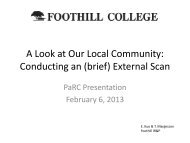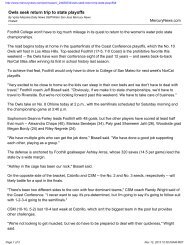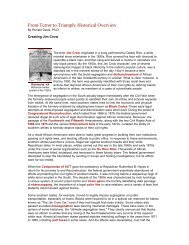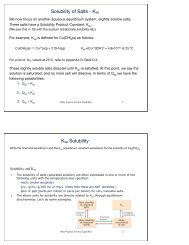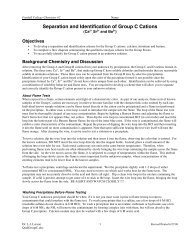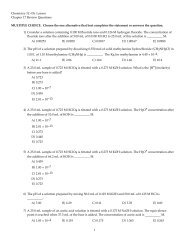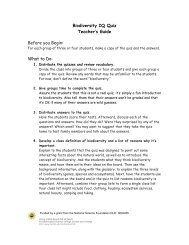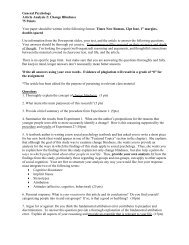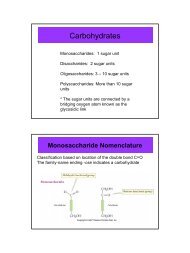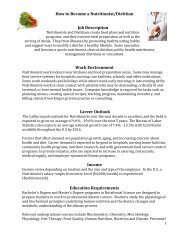You also want an ePaper? Increase the reach of your titles
YUMPU automatically turns print PDFs into web optimized ePapers that Google loves.
Copyright © 2010 Pearson<br />
Education, Inc.<br />
<strong>21.8</strong> <strong>The</strong> <strong>Citric</strong> <strong>Acid</strong> <strong>Cycle</strong><br />
• <strong>The</strong> carbon atoms from the first two stages of<br />
catabolism are carried into the third stage as<br />
acetyl groups bonded to coenzyme A.<br />
• Like the phosphoryl groups in ATP molecules, the<br />
acetyl groups in acetyl-SCoA molecules are<br />
readily removed in an energy-releasing hydrolysis<br />
reaction.<br />
Chapter Twenty One 1
• Oxidation of two carbons to give CO 2 and transfer<br />
of energy to reduced coenzymes occurs in the<br />
citric acid cycle, also known as the tricarboxylic<br />
acid cycle (TCA) or Krebs cycle (after Hans Krebs,<br />
who unraveled its complexities in 1937).<br />
► <strong>The</strong> citric acid cycle is a closed<br />
loop of reactions in which the<br />
product of the final step which has<br />
four carbon atoms, is the reactant<br />
in the first step.<br />
Copyright © 2010 Pearson<br />
Education, Inc.<br />
Chapter Twenty One 2
• <strong>The</strong> net result of the citric acid cycle is:<br />
– Production of four reduced coenzyme molecules,<br />
3 NADH and 1 FADH 2<br />
– Conversion of an acetyl group to two CO 2<br />
molecules<br />
– Production of one energy-rich molecule (GTP)<br />
• ADP acts as an allosteric activator for the<br />
enzyme for Step 3. NADH acts as an inhibitor<br />
of the enzyme for Step 3.<br />
• By such feedback mechanisms, the cycle is<br />
activated when energy is needed and<br />
inhibited when energy is in good supply.<br />
• <strong>The</strong> eight steps of the citric acid cycle are<br />
shown in greater detail on the next slide.<br />
Copyright © 2010 Pearson<br />
Education, Inc.<br />
Chapter Twenty One 3
Copyright © 2010 Pearson<br />
Education, Inc.<br />
Chapter Twenty One 4
21.9 <strong>The</strong> Electron-Transport Chain and<br />
Copyright © 2010 Pearson<br />
Education, Inc.<br />
ATP Production<br />
• At the conclusion of the citric acid cycle, the<br />
reduced coenzymes formed in the cycle are ready<br />
to donate their energy to making additional ATP<br />
• Hydrogen and electrons from NADH and FADH 2<br />
enter the electron-transport chain at enzyme<br />
complexes I and II, respectively.<br />
• <strong>The</strong> enzyme for Step 6 of the citric acid cycle is<br />
part of complex II. FADH 2 produced there does<br />
not leave complex II. Instead it is immediately<br />
oxidized there by reaction with coenzyme Q.<br />
• Following formation of the mobile coenzyme Q,<br />
reductions occur when electrons are transferred.<br />
Chapter Twenty One 5
► Coenzyme Q is also known as ubiquinone because of its widespread occurrence<br />
and because its ring structure with the two ketone groups is a quinone.<br />
• Electrons are passed from weaker to<br />
increasingly stronger oxidizing agents, with<br />
energy released at each transfer.<br />
Copyright © 2010 Pearson<br />
Education, Inc.<br />
Chapter Twenty One 6
Other important electron acceptors are various<br />
cytochromes, which are proteins that contain<br />
heme groups in which the iron cycles between<br />
Fe +2 and Fe +3 and proteins with iron–sulfur<br />
groups in which the iron also cycles between Fe +2<br />
and Fe +3 .<br />
Copyright © 2010 Pearson<br />
Education, Inc.<br />
Chapter Twenty One 7
H + ions are released for transport through the inner<br />
membrane at complexes I, III, and IV. Some of these<br />
ions come from the reduced coenzymes.<br />
Copyright © 2010 Pearson<br />
Education, Inc.<br />
Chapter Twenty One 8
• <strong>The</strong> H + concentration difference creates a potential<br />
energy difference across the two sides of the inner<br />
membrane (like the energy difference between water<br />
at the top and bottom of the waterfall).<br />
• <strong>The</strong> maintenance of this concentration gradient<br />
across the membrane is crucial—it is the mechanism<br />
by which energy for ATP formation is made available.<br />
• ATP synthase: <strong>The</strong> enzyme complex in the inner<br />
mitochondrial membrane at which H + ions cross the<br />
membrane and ATP is synthesized from ADP.<br />
Copyright © 2010 Pearson<br />
Education, Inc.<br />
Chapter Twenty One 9
• Oxidative phosphorylation:<br />
<strong>The</strong> synthesis of ATP from ADP<br />
using energy released in the<br />
electron transport chain.<br />
• Each of the enzyme complexes<br />
I–IV contains several electron<br />
carriers.<br />
• In the last step of the chain,<br />
electrons combine with<br />
oxygen that we breathe and<br />
H + ions from the surroundings<br />
to produce water.<br />
Copyright © 2010 Pearson<br />
Education, Inc.<br />
Chapter Twenty One 10
21.10 Harmful Oxygen By-Products<br />
Copyright © 2010 Pearson<br />
Education, Inc.<br />
and Antioxidant Vitamins<br />
• More than 90% of the oxygen we breathe is used in<br />
electron transport– ATP synthesis reactions.<br />
• In these and other oxygen-consuming redox<br />
reactions, the product may not be water, but one or<br />
more of three highly reactive species.<br />
• <strong>The</strong> superoxide ion, ·O 2 - , and the hydroxyl free<br />
radical, ·OH, can grab an electron from a bond in<br />
another molecule, which results in breaking that<br />
bond. <strong>The</strong> third oxygen by-product is hydrogen<br />
peroxide, H 2O 2 , a relatively strong oxidizing agent.<br />
Chapter Twenty One 11
Conditions that can enhance production of these<br />
three reactive oxygen species are represented in the<br />
drawing below. Some causes are environmental, such<br />
as exposure to smog or radiation. Others are<br />
physiological, including aging and inflammation.<br />
Copyright © 2010 Pearson<br />
Education, Inc.<br />
Chapter Twenty One 12
• Our protection against harmful oxygen species is<br />
provided by superoxide dismutase and catalase,<br />
which are among the fastest-acting enzymes.<br />
• <strong>The</strong>se and other enzymes are active inside cells<br />
where oxygen by-products are constantly generated.<br />
It is estimated that 1 in 50 of the harmful oxygen<br />
species escapes destruction inside a cell.<br />
Copyright © 2010 Pearson<br />
Education, Inc.<br />
Chapter Twenty One 13
• Protection is also provided by the antioxidant<br />
vitamins E, C, and A , all of which disarm free radicals<br />
by bonding with them.<br />
• Vitamin E is fat-soluble, and its major function is to<br />
protect cell membranes from potential damage.<br />
Copyright © 2010 Pearson<br />
Education, Inc.<br />
Chapter Twenty One 14




